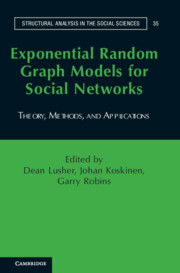Book contents
- Frontmatter
- Contents
- List of Figures
- List of Tables
- 1 Introduction
- Section I Rationale
- Section II Methods
- 6 Exponential Random Graph Model Fundamentals
- 7 Dependence Graphs and Sufficient Statistics
- 8 Social Selection, Dyadic Covariates, and Geospatial Effects
- 9 Autologistic Actor Attribute Models
- 10 Exponential Random Graph Model Extensions: Models for Multiple Networks and Bipartite Networks
- 11 Longitudinal Models
- 12 Simulation, Estimation, and Goodness of Fit
- 13 Illustrations: Simulation, Estimation, and Goodness of Fit
- Section III Applications
- Section IV Future
- References
- Index
- Name Index
8 - Social Selection, Dyadic Covariates, and Geospatial Effects
Published online by Cambridge University Press: 05 April 2013
- Frontmatter
- Contents
- List of Figures
- List of Tables
- 1 Introduction
- Section I Rationale
- Section II Methods
- 6 Exponential Random Graph Model Fundamentals
- 7 Dependence Graphs and Sufficient Statistics
- 8 Social Selection, Dyadic Covariates, and Geospatial Effects
- 9 Autologistic Actor Attribute Models
- 10 Exponential Random Graph Model Extensions: Models for Multiple Networks and Bipartite Networks
- 11 Longitudinal Models
- 12 Simulation, Estimation, and Goodness of Fit
- 13 Illustrations: Simulation, Estimation, and Goodness of Fit
- Section III Applications
- Section IV Future
- References
- Index
- Name Index
Summary
Individual, Dyadic, and Other Attributes
In this chapter, we introduce models that include effects for actor attributes and dyadic covariates. Actor attributes are individual-level measures on the nodes of the network. Social selection models examine whether attribute-related processes affect network ties (e.g., homophily processes whereby network ties tend to occur between individuals with similar actor attributes) (McPherson, Smith-Lovin, & Cook, 2001). A dyadic covariate, in contrast, is a measure on each dyad, that is, on a pair of actors, and may similarly affect the presence of a tie. For instance, in a study of a trust network within an organization, the formal organizational hierarchy might partly shape the formation of trust ties. In that case, inclusion of the hierarchy as a dyadic covariate permits inferences about whether trust ties tend to align with hierarchical relationships (e.g., Tom is the boss of Fred). A binary dyadic covariate can be used to represent whether people share the same attribute or membership – that is, work at the same place, live in the same household, or attend the same church. Continuous dyadic covariates are also possible. Although spatial embedding of networks, to an extent, can be captured by dyadic continuous covariates, geospatial effects are a distinctive feature, so we provide a separate section in this chapter.
The preceding chapters outline the general ERGM methodology but concentrate exclusively on models for endogenous tie-based effects. The presence or absence of individual ties is affected by a surrounding neighborhood of other ties, with that neighborhood determined by the prevailing dependence assumption. These endogenous effects represent processes of network self-organization.
- Type
- Chapter
- Information
- Exponential Random Graph Models for Social NetworksTheory, Methods, and Applications, pp. 91 - 101Publisher: Cambridge University PressPrint publication year: 2012
- 12
- Cited by

